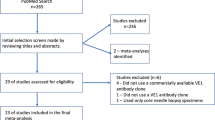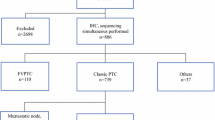Abstract
The aim of this study was to investigate the concordance between BRAFV600E mutation test and immunohistochemistry (IHC) and determine the diagnostic accuracy of IHC for papillary thyroid carcinoma (PTC) through a systematic review, meta-analysis, and diagnostic test accuracy review. The current systematic review and meta-analysis included 1141 PTCs in 11 eligible studies. We investigated the concordance rate and performed subgroup analysis using tissue and cytologic samples. Diagnostic test accuracy review was conducted and calculated using the value of area under curve (AUC) on the summary receiver operating characteristic (SROC) curve. The positive rate of BRAF IHC was 79.1 % (903 of 1141 cases), and the BRAFV600E mutation was found in 76.6 % (874 of 1141 cases). The concordance rates were 0.921 (95 % confidence interval (CI) 0.877–0.950) and 0.894 (95 % CI 0.801–0.946) in IHC positive and negative subgroups, respectively. In the diagnostic test accuracy review, the pooled sensitivity and specificity were 0.97 (95 % CI 0.95–0.98) and 0.78 (95 % CI 0.72–0.83). The value of AUC on SROC curve was 0.983, and diagnostic odds ratio was 164.28 (95 % CI 57.69–467.80). Our results showed that BRAF IHC was strongly concordant with BRAF mutation test and had high diagnostic accuracy in BRAF mutation analysis of PTC.



Similar content being viewed by others
References
Pyo JS, Kang G, Kim DH et al. (2013) Activation of nuclear factor-κB contributes to growth and aggressiveness of papillary thyroid carcinoma. Pathol Res Pract 209:228–232.
Giordano TJ, Kuick R, Thomas DG, et al. (2005) Molecular classification of papillary thyroid carcinoma: distinct BRAF, RAS, and RET/PTC mutation-specific gene expression profiles discovered by DNA microarray analysis. Oncogene 24:6646–6656.
Kwak JY, Kim EK, Kim JK et al. (2010) Dual priming oligonucleotide-based multiplex PCR analysis for detection of BRAFV600E mutation in FNAB samples of thyroid nodules in BRAFV600E mutationprevalent area. Head Neck 32:490–498.
Lee HJ, Choi J, Hwang TS et al. (2010) Detection of BRAF mutations in thyroid nodules by allele-specific PCR using a dual priming oligonucleotide system. Am J Clin Pathol 133:802–808.
Oh WJ, Lee YS, Cho U, et al. (2014) Classic papillary thyroid carcinoma with tall cell features and tall cell variant have similar clinicopathologic features. Korean J Pathol. 48:201–208.
Xing M (2007) BRAF mutation in papillary thyroid cancer: pathogenic role, molecular bases, and clinical implications. Endocrine Reviews 28:742–762.
Nucera C, Porrello A, Antonello ZA et al. (2010) B-Raf(V600E) and thrombospondin-1 promote thyroid cancer progression. Proc Natl Acad Sci USA 107:10649–10654.
Ito Y, Yoshida H, Maruo R et al. (2009) BRAF mutation in papillary thyroid carcinoma in a Japanese population: its lack of correlation with high-risk clinicopathological features and disease-free survival of patients. Endocr J 56:89–97.
Xing M, Westra WH, Tufano RP et al. (2005) BRAF mutation predicts a poorer clinical prognosis for papillary thyroid cancer. J Clin Endocrinol Metab 90:6373–6379.
Liu RT, Chen YJ, Chou FF et al. (2005) No correlation between BRAFV600E mutation and clinicopathological features of papillary thyroid carcinomas in Taiwan. Clin Endocrinol (Oxf) 63:461–466.
Bullock M, O’Neill C, Chou A et al. (2012) Utilization of a MAB for BRAF(V600E) detection in papillary thyroid carcinoma. Endocr Relat Cancer 19:779–784.
McKelvie PA, Chan F, Yu Y et al. (2013) The prognostic significance of the BRAF V600E mutation in papillary thyroid carcinoma detected by mutation-specific immunohistochemistry. Pathology 45:637–644.
Routhier CA, Mochel MC, Lynch K et al. (2013) Comparison of 2 monoclonal antibodies for immunohistochemical detection of BRAF V600E mutation in malignant melanoma, pulmonary carcinoma, gastrointestinal carcinoma, thyroid carcinoma, and gliomas. Hum Pathol 44:2563–2570.
Zagzag J, Pollack A, Dultz L et al. (2013) Clinical utility of immunohistochemistry for the detection of the BRAF v600e mutation in papillary thyroid carcinoma. Surgery 154:1199–1204.
Crescenzi A, Guidobaldi L, Nasrollah N et al. (2014) Immunohistochemistry for BRAF(V600E) antibody VE1 performed in core needle biopsy samples identifies mutated papillary thyroid cancers. Horm Metab Res 46:370–374.
Dvorak K, Aggeler B, Palting J et al. (2014) Immunohistochemistry with the anti-BRAF V600E (VE1) antibody: impact of pre-analytical conditions and concordance with DNA sequencing in colorectal and papillary thyroid carcinoma. Pathology 46:509–517.
Ilie MI, Lassalle S, Long-Mira E et al. (2014) Diagnostic value of immunohistochemistry for the detection of the BRAF(V600E) mutation in papillary thyroid carcinoma: comparative analysis with three DNA-based assays. Thyroid 24:858–866.
Kim YH, Choi SE, Yoon SO et al. (2014) A testing algorithm for detection of the B-type Raf kinase V600E mutation in papillary thyroid carcinoma. Hum Pathol 45:1483–1488.
Rossi ED, Bizzarro T, Martini M et al. (2014) Morphological parameters able to predict BRAF(V600E)-mutated malignancies on thyroid fine-needle aspiration cytology: Our institutional experience. Cancer Cytopathol 122:883–891.
Zimmermann AK, Camenisch U, Rechsteiner MP et al. (2014) Value of immunohistochemistry in the detection of BRAF(V600E) mutations in fine-needle aspiration biopsies of papillary thyroid carcinoma. Cancer Cytopathol 122:48–58.
Jung YY, Yoo JH, Park ES et al. (2015) Clinicopathologic correlations of the BRAF(V600E) mutation, BRAF V600E immunohistochemistry, and BRAF RNA in situ hybridization in papillary thyroid carcinoma. Pathol Res Pract 211:162–170.
Zamora J, Abraira V, Muriel A et al. (2006) Meta-DiSc: a software for meta-analysis of test accuracy data. BMC Med Res Methodol 6:31.
Li F, Chen G, Sheng C et al. (2015) BRAFV600E mutation in papillary thyroid microcarcinoma: a meta-analysis. Endocr Relat Cancer 22:159–168.
Koperek O, Kornauth C, Capper D et al. (2012) Immunohistochemical detection of the BRAF V600E-mutated protein in papillary thyroid carcinoma. Am J Surg Pathol 36:844–850.
Leeflang MM, Deeks JJ, Takwoingi Y et al. (2013) Cochrane diagnostic test accuracy reviews. Syst Rev 2:82.
Capper D, Preusser M, Habel A et al. (2011) Assessment of BRAF V600E mutation status by immunohistochemistry with a mutation-specific monoclonal antibody. Acta Neuropathol 122:11–19.
Mordes DA, Lynch K, Campbell S et al. (2014) VE1 antibody immunoreactivity in normal anterior pituitary and adrenal cortex without detectable BRAF V600E mutations. Am J Clin Pathol 141:811–815.
Jones RT, Abedalthagafi MS, Brahmandam M et al. (2014) Cross-reactivity of the BRAF VE1 antibody with epitopes in axonemal dyneins leads to staining of cilia. Mod Pathol 28:596–606.
Conflict of Interest
The authors declare that they have no conflict of interest.
Author information
Authors and Affiliations
Corresponding author
Rights and permissions
About this article
Cite this article
Pyo, JS., Sohn, J.H. & Kang, G. BRAF Immunohistochemistry Using Clone VE1 is Strongly Concordant with BRAFV600E Mutation Test in Papillary Thyroid Carcinoma. Endocr Pathol 26, 211–217 (2015). https://doi.org/10.1007/s12022-015-9374-7
Published:
Issue Date:
DOI: https://doi.org/10.1007/s12022-015-9374-7




